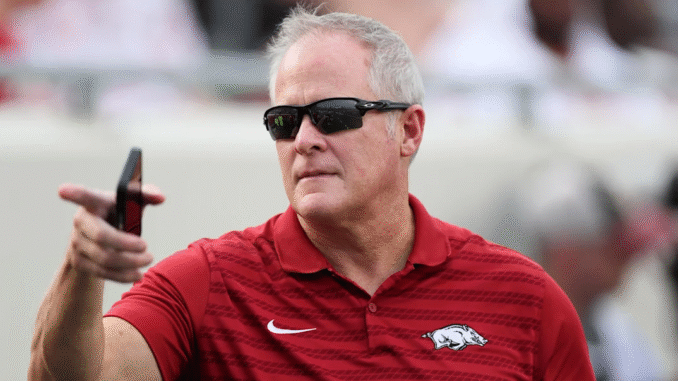
When money officially entered college athletics through NIL — or rather, stepped out of the shadows — it was only a matter of time before politics followed.
Last Friday, Arkansas Governor Sarah Huckabee Sanders signed legislation amending the state’s NIL law. The updates allow for revenue sharing, make payments from Arkansas universities to student-athletes exempt from state income tax, and shield those transactions from public records requests. It’s the revenue-sharing piece, in particular, that has stirred up controversy among Arkansans.
At a fundamental level, I understand the frustration. It makes sense that hardworking taxpayers — many of whom already feel burdened by what they owe each year — would be upset seeing young athletes exempt from those same financial pressures simply because of their athletic status. It feels unfair.
But here’s the thing: life isn’t fair. We’re taught that from a young age, yet it’s a reality we often choose to ignore.
Still, fairness isn’t the question we should be asking here. Instead, as fans of Arkansas sports — or simply as citizens of the Natural State — the real question is: Is it worth it?
Let’s Start With the Drawbacks
The Cost of Tax-Exempt NIL Payments
First, it’s important to note that this law doesn’t just apply to Razorback football or basketball. It affects every student-athlete in Arkansas. According to an annual report from the Arkansas Department of Education, that includes 4,132 athletes across 10 four-year universities and eight two-year colleges statewide.
Now, not every student-athlete is signing million-dollar endorsement deals. While a few high-profile names cash in big, the vast majority of athletes make far less. In fact, the data backs this up.
In August 2024, NIL Daily (a Sports Illustrated offshoot) reported that the average NIL earnings per athlete were $21,331. But the median? Just $480. That massive gap reveals the data is heavily skewed by a few high-dollar deals at the top. Most student-athletes earn little or nothing from NIL — a crucial detail that often gets lost in headlines.
Still, let’s work with that average for the sake of analysis. If every one of the 4,132 student-athletes in Arkansas made $21,331, the total NIL earnings would reach around $88.1 million. Now, let’s assume — hypothetically — that each athlete falls into Arkansas’ top income tax bracket of 3.9% (though most don’t). That amounts to about $3.43 million in potential state tax revenue lost under the new law.
Other than some bruised feelings, that’s really the extent of the downside when it comes to exempting NIL payments from state taxes. And in the grand scheme of Arkansas’ finances, it’s barely a blip. According to Talk Business & Politics, Arkansas brought in $2.569 billion in personal income taxes in just the first nine months of the 2024–25 fiscal year. If that pace holds, the state will hit around $3.425 billion by the end of June.
So, what’s the actual hit? Assuming every student-athlete was taxed at the highest income bracket (which they’re not), the state would miss out on about $3.43 million — just 0.1% of Arkansas’ total personal income tax revenue.
If that number still feels abstract, here’s a more grounded comparison. Public education eats up a large portion of state income tax funds. Take the Springdale School District, Arkansas’ largest, with 22,745 students according to Niche.com. At roughly $13,000 per student, the district’s estimated annual budget is $303 million. Even if NIL income were taxed at the highest rate, it would only cover about 1% of Springdale’s costs. The district would still need $299.6 million from other sources.
What Are the Benefits?
Now that we’ve examined the cost, let’s talk about the upside — and it’s a compelling one. The main reason for passing this bill was strategic: to give Arkansas schools an edge in recruiting.
Even with the state tax exemption, NIL earnings are still subject to federal taxes, which can climb as high as 37%. When you include state income taxes, athletes could see nearly half their earnings vanish to taxes. So, if Arkansas can offer a better take-home share than other states, that’s a powerful recruiting tool.
I love the state of Arkansas. You love the state of Arkansas. And players who come here — especially to play for the Razorbacks — often grow to love it, too. But let’s be honest: nationally, Arkansas doesn’t always have the best reputation. That can make it hard to get top recruits to even consider visiting. Florida has sunshine, beaches, and no income tax. Recruits notice those things. And those are the kinds of recruiting battles our coaches are fighting.
The Broader Impact
And for Arkansans who don’t follow the Razorbacks — we haven’t forgotten you — there’s still something in this for you. Stronger recruiting translates to stronger athletic programs. And better programs mean bigger economic returns.
In 2015, an independent study from the University of Arkansas’ Center for Business and Economic Research found that Razorback athletics contributed $153.6 million annually to the state economy. But that number isn’t guaranteed. If recruiting slips, so does on-field performance. Fewer wins means fewer fans in the stands. And fewer fans means less economic activity — from hotels and restaurants to merchandise and media exposure.
There’s also the community impact of NIL. Many contracts require athletes to give back through service — and they do. Arkansas athletes have served in soup kitchens, run food drives, and helped families during the holidays. Some even donate part of their earnings. Kicker Cam Little, for instance, gave $50 to charity for every field goal he made. By the time he left for the NFL, he’d donated $1,460 — just from kicks.
So no, this legislation isn’t a slap in the face to Arkansas taxpayers. It’s a calculated move. I’m no economist, but the cost-benefit analysis here is clear: Arkansas may lose a small slice of tax revenue, but what it gains in recruiting power, economic return, and community engagement is likely worth far more.

Leave a Reply